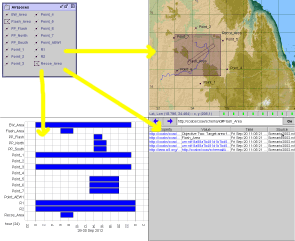

Decision Desktop is a flexible, customisable tool that augments decision-maker's cognition by enabling them to acquire, visualise and manipulate diverse and dynamic information - however they wish and whenever they need it.
Decision-makers require access to ‘pools of information’ distributed across an organisation, but current systems are too often hardwired to specific, inflexible data formats.
Organisations may require data from new partners, or new sources, to be fed into existing systems at short notice. Existing systems cannot cope with new data types or changes to legacy data formats at run-time.
People often need to keep track of the source, reliability and age of information items, and handle information overload, multiple conflicting reports, and uncertainty.
Warfighters should be able to customise their displays during execution to meet the military imperative, not have to use ones hardwired at design time. Conflict is unpredictable and dynamic, and so requires flexible tools.
The Decision Desktop is a system that meets these needs.

Customisable visualisation, using plug-in objects to control extraction, filtering and appearance of information
Decision Desktop consists of a collection of customisable views onto information.
Each view addresses a different form of visualisation - each with its own 'modality'. For example, maps show location, Gantt charts show time. New types of view can be plugged-in as required without changing any existing software.
A back-end data management system handles information in a uniform way, tagging it with metadata such as source and timestamp.
The user interacts with the system by dragging objects to views, selecting and filtering information about these objects, and choosing the desired visualisations.
The Decision Desktop is process-neutral; it is driven by the user to support their current needs and imperatives; it does not impose procedures or processes on the user.
Decision Desktop can integrate information from diverse sources, using software agents to find and translate data.
Such information can be visualised in a variety of ways by adding it to a view, then choosing and configuring components such as filters, palettes and symbol libraries. New components can be added at any time if required.

Same data, different views
Information can be filtered according to its source, age, or any other arbitrary criteria.
The management of uncertainty and conflicting data is integral to the system, allowing users to make their own decisions and choices.
The Decision Desktop allows users to ‘drill down’ to the underlying data to understand higher-level visualisations.
Users can save their personal set of views and transfer them to other computing devices.
A basic core framework is enhanced with plug-in components for processing, viewing, colouring and filtering information.
Decision Desktop components are entirely independent of one another and so can be added or removed at runtime. They can store their state for later recall or sharing with others.

Basic Concepts
Views query the data store to find attributes such as location or time to create a meaningful display, even for unexpected data types. New object types can thus be displayed with no code changes.
Data are processed using modern Semantic Web technologies, enabling machines to reason effectively with the information, discover implicit knowledge and behave more intelligently.
Decision Desktop uses software agents to acquire and translate data from diverse distributed sources.
For further information please contact:
Mr David Palmer